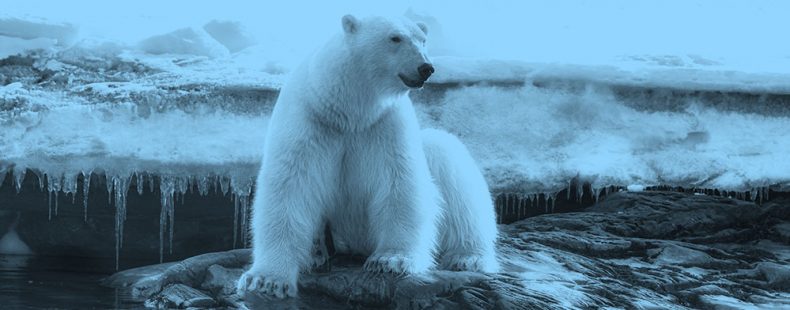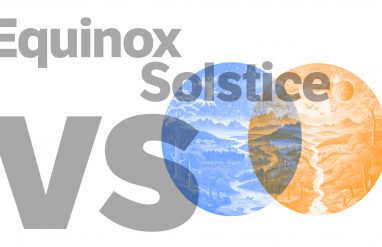The language surrounding climate change is changing right alongside the climate itself. But, it all began with global warming …
What is global warming and greenhouse gases?
Climate change was first known to many of us as global warming, a phrase dating to the 1950s that indicates “a longterm rise in Earth’s average atmospheric temperature.” The idea that global warming exists and could be attributed to human behavior, however, was first put forward in 1896 by Swedish scientist Svante Arrhenius. Over the next century, as technology improved, scientists continued to measure the temperatures of the oceans and record rising levels of greenhouse gases in the atmosphere.
Another key climate change term attested by 1975, greenhouse gases, like carbon dioxide and methane, lead to the atmospheric heating phenomenon of the greenhouse effect, which contributes to global warming. The phenomenon, likened to the way heat gets trapped inside a greenhouse, was first described by Joseph Fourier in 1827, though not called as such until the early 1900s.
The term global warming went mainstream in the late 1980s, when NASA scientist James Hansen testified before Congress that the scientific community could “ascribe with a high degree of confidence a cause and effect relationship” between greenhouse gases and global warming. In 2006, former Vice President Al Gore gave the phrase another major boost when he released the documentary An Inconvenient Truth, which explained the concept of global warming and the mounting scientific evidence that humans are treading a dangerous path if we don’t reduce our carbon emissions.
But, the term global warming seemed to confuse some into thinking that the Earth would just continue to get warmer and warmer and, eventually, there would be no more winter. It’s a misconception that persists today.
So, over time, scientists and media outlets began to favor the phrase climate change.
WATCH: What Is The Difference Between "Weather" vs. "Climate"?
Global warming vs. climate change
Climate change is a term that better encompasses the myriad longterm changes to the climate that can be brought on by an increase in Earth’s average temperature. These effects include more heat waves and rising sea levels as polar ice caps melt, but they also include extreme cold, droughts, floods, fires, and catastrophic storms.
⚡️ Why climate change became popular
While attested since the 1850s and notably used in some 1950s research and reporting, the phrase climate change spread in the 1980s. There was no official call for everyone to start saying climate change instead of global warming, and it’s a myth that scientists changed the name global warming to climate change because they weren’t finding evidence for average rises in temperature across the globe. You can still find resources that use both terms.
However, many organizations, such as NASA, use climate change more frequently because it encompasses all of the predicted effects of global warming and “temperature change itself isn’t the most severe effect of changing climate.” (It’s changes in sea levels and precipitation patterns.)
Crisis, emergency, breakdown, and disaster
In 2018, the Intergovernmental Panel on Climate Change (IPCC) released a report on climate change that included many warnings about severe negative consequences that would result from the current rate of increasing global temperature. In response to this report, new terms would emerge in the following years that emphasized the urgency of climate change. Often, the choice of which term is used depends on who is using it and how strongly they want their audience to feel about the urgency of combating climate change. Sometimes, a person may also simply use the word climate when referring to climate change and its potential negative impacts as in Voters often considered climate to be a major issue.
The term climate crisis had appeared in scientific articles since at least 2009, but this term has recently been commonly used by world governments and the United Nations. Often, climate crisis is used when discussing actions, initiatives, or legislation that could be enacted to try to fight climate change. The term climate emergency is similarly used by the UN and governments when declaring emergency actions based on climate change or asking for funding for climate change initiatives. Both of these terms are often used by politicians, scientists, and the media, particularly when discussing governmental policy around trying to combat climate change. For example, the Guardian newspaper updated its style guide in 2019 noting that climate change is too passive and favoring terms like climate crisis, climate emergency, and climate breakdown.
The term climate breakdown is less commonly used but may appear in scientific pieces interested in the sociological effects of climate change and how severe climate change may negatively impact society as a whole. Climate disaster is the most recent term to emerge, having been used by a UN representative in 2022. Climate disaster is mostly used by the media, especially when referring to extreme natural disasters caused by climate change. Both climate breakdown and climate disaster are usually chosen by a writer or speaker who wants to strongly emphasize the urgency of needing to combat climate change.
All four of these terms, in one way or another, emphasize the severity of climate change and stress the urgency of societal change needed to combat it. As language around climate change, especially in the media, increasingly emphasizes the worsening state of global climate, we are likely to see even more terms emerge in the future.
Other terms around climate change
We’ve identified some of the latest terms surrounding climate change to have on your radar. Learning these words is vital to understanding the issue of climate change as a whole.
polar vortex
The term polar vortex has gone viral several times since 2014 as this weather phenomenon has brought extremely cold temperatures to parts of North America and Europe. The vortex itself is “a mass of swirling cold air that naturally exists at the Earth’s poles.” During winter in the Northern Hemisphere, the vortex expands, sending arctic air blasting especially through parts of Canada and the US and contributing to such wild weather events (and words) as bomb cyclone and bombogenesis.
This is a normal occurrence, but the reason that it’s being linked to climate change is because scientists believe retreating sea ice in the Arctic is warming the ocean even more, releasing heat into the atmosphere and spurring winds that cause the polar vortex to travel farther south than usual and into populated areas. At certain points during a polar vortex in January 2019, it was ten degrees colder in Chicago than in Antarctica!
Green New Deal
The Green New Deal (GND) is a first-of-its-kind plan to fight climate change introduced by Senator Ed Markey (D-MA) and Representative Alexandria Ocasio-Cortez (D-NY) in February 2019. Essentially, it’s a program of investments into clean-energy jobs and infrastructure, with the aim of decarbonizing—another climate change term we’re keeping our eye on—the economy by shifting away from fossil fuels.
The plan takes its name from Franklin Delano Roosevelt’s New Deal in the 1930s, which was a series of programs and economic reforms to provide relief from the Great Depression. Green, here, refers to something “environmentally sound or beneficial.”
Details of the GND are still in flux, but they reportedly include proposals to build high-speed train lines, invest in zero-emission vehicles, and generate 100 percent of electricity from zero-emission sources. Zero-emission means “emitting no harmful pollutants,” another important term in our expanding language of climate change.
microplastics
If everyone seems more panicked about plastic than usual, it’s likely because of fears about microplastics.
As plastic pollutes oceans and waterways, it degrades into smaller pieces. Plastics that are less than five millimeters in length (about the size of a sesame seed) have been called microplastics since at least the 1990s, and these tiny plastics are polluting every body of water on Earth.
They’ve been found everywhere from deserted places like the Arctic—to human stool. As the effects of climate change worsen, scientists expect trapped microplastics to be released by melting sea ice. The ramifications of this aren’t clear yet, but they could potentially be carried around the globe, further contaminating our food systems and threatening aquatic life.
Another plastic-based word (and concern) is single-use plastics, or plastic items used once and then thrown away, such as water bottles or straws. This waste has led companies like Starbucks to eliminate the use of straws in their products.
ocean acidification
As if tons of microplastics weren’t a big enough problem, scientists also believe our warming planet is causing ocean acidification. This means the ocean is becoming more acidic, and it’s causing the ocean floor to dissolve.
The ocean floor is made of calcite, “a mineral formed by the skeletal remnants and shells of marine organisms,” NBC explains. When atmospheric carbon dioxide seeps into oceans, calcite helps neutralize it. But, the oceans are becoming overloaded with CO₂, which is depleting calcite and causing oceans to become more acidic. As NBC reports, scientists warn that something similar happened during the Permian-Triassic extinction, which caused over 90 percent of marine species to go extinct.
climate refugees
A refugee is “someone who is forced to flee for their own safety, especially to a foreign country.” NPR reports that since 2008, more than 24 million people have been displaced by catastrophic weather events. These people, forced to flee from drought, floods, and deadly storms, are called climate refugees, a term evidenced since at least 1995.
The World Bank estimates that, by 2050, over 143 million people could be displaced by the effects of climate change, which could include greater food insecurity, more natural disasters, more inhospitable environments, and higher sea levels. January 2019 findings from the Pentagon warned that climate change and the resulting forced migration could pose threats to national security.
negawatt
You’ve probably heard the term megawatt, which is “a unit of power, equal to one million watts.” These days, there’s increasing talk about the negawatt.
A negawatt is “a unit of energy that is saved by conserving energy.” The term—modeled after megawatt and whose “opposite”—denoting nega which is shortened from negative—has been around since 1984, but it’s only recently that we’ve paid attention to its true potential.
According to energy policy expert Amory Lovins, since 1975, the US has gotten 30 times more energy from energy savings as we have from renewable energy output. In other words, evidence seems to suggest that, in the fight against climate change, creating energy-saving technologies may be even more beneficial than harnessing alternative energy sources. As things like the Green New Deal encourage us to rethink the ways we get energy, expect to see negawatts being discussed more often.
solastalgia
Climate change isn’t just having an effect on our environment. It’s also having an effect on our mental health and well-being. Environmental change can cause very real distress and anxiety, as experiences of such events as severe drought or wildfire brought on by climate change disrupt people’s livelihoods and communities.
In the early 2000s, environmental philosopher Glenn Albrecht first named this environmental distress solastalgia. In a 2007 study of drought and coal-mining in Australia, for instance, Albrecht concluded that “people exposed to environmental change experienced negative affect that is exacerbated by a sense of powerlessness or lack of control over the unfolding change process.”
Modeled on nostalgia, solastalgia ultimately joins the Latin solacium (“comfort, solace”) with the Greek algos, “pain.”
Test yourself on these important terms by taking our quiz.
How do we move forward?
The idea of climate change is scary and overwhelming to most people, but knowing the right words to use to describe what’s happening and potential ways to solve problems is a powerful tool in not only managing our collective anxiety—our solastalgia—about climate change, but also in starting discussions that could lead to meaningful action.
As scientists have told us again and again, avoiding these issues won’t make them go away, no matter how inconvenient the truth may be. Addressing them in our language is at least one, if small, place to start.













